
Today’s products allow you to delay or avoid switching to a power chair, preserve your hands and shoulders, and easily wheel on difficult terrain.
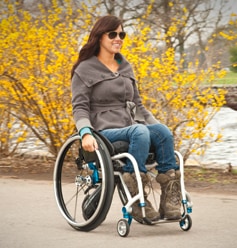
Photo by Robert Glover
A properly designed and fitted active lightweight chair makes wheeling easier and more efficient. Yet even with the best fit and design, there is a limit — a chair requires a certain amount of arm strength and endurance to meet daily mobility requirements. The limit may come from spinal cord injury level, progression of a disease or neurological condition, from aging, or from the toll that years of the repetitive stress of pushing takes on hands, wrists, and shoulders — any of these can lessen the ability to push a manual chair.
Switching to a power chair is a change that wheelers are reluctant to make for a variety of reasons, not the least of which is the added cost of needing an adaptive van for transportation and the loss of spontaneity that a manual chair affords — you can’t toss a power chair in the trunk of a car or fit it in a standard taxi on a whim. Switching to a power chair can also cause weight gain, as you no longer get the three-calorie-per-minute exercise that pushing a manual chair on flat ground burns. Lack of pushing movement also causes a loss of muscle tone and strength, and less movement can sap energy.
But limits are meant to be broken.
These days you can delay or avoid switching to a power chair. There are a number of cool add-on products designed to extend your ability to use a manual chair. Just as important, many of these products make wheeling easier now, to help preserve shoulders, hands and wrists for the long haul. Here is a list to consider:
Manual Add-Ons
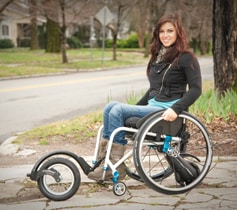
Photo by Robert Glover
FlexRim Pushrim by Spinergy: FlexRims use an ergonomically-designed high friction rubber surface between the wheel and push rim instead of metal tabs to hold the rim. The result is amazing handgrip traction, which, combined with the flex of the rubber, reduces pushing stress and impact on hands, wrists, and shoulders. And the smooth hand rims enable no-burn braking. Plus, FlexRims have the ability to squeeze inward — about an inch — which can be just enough to fit through narrower doorways.
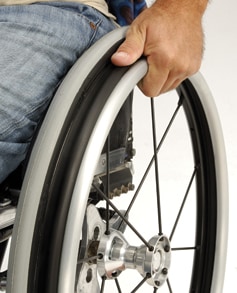
Marc McLean, 43, from Cape Corrals, Fla., in his 26th year as a C5-6 quad, has been using the FlexRim for five years. “I don’t have any finger movement, so I push the chair with the heel of my hand. The rubber surface enables me to get enough traction with the heel of my hand to get a good push, and I can use the smooth push rim to slow the chair without burning my hands,” says McLean. “Before the FlexRim I had to push on my tires, so my hands were always filthy and callused, or worse, covered in dog shit. Now my hands stay clean and my calluses have gone away. Another bonus is the FlexRim flex — the extra inch of squeeze has often enabled me to squeeze into a non-accessible bathroom.”
Suggested retail: $1,270 a pair.
Surge Pushrim: The Surge pushrim by Out-Front features an ergonomic oval shape designed to reduce wrist, hand and arm strain, and has a rubber “Gription Strip” on the top of the rim for traction and smooth sides for no-burn braking.
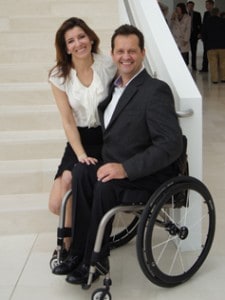
Fred Nilsson, 47, from Overland Park, Kan., in his 35th year as a T9 para, has been using Surge push rims on his TiLite ZR chair for the past year. “They are fantastic,” says Nillson. “I get plenty of torque on the rubber strip without straining to grip, and the smooth push rim sides allow me to stop without burning my hands.” He says not having to aggressively grab the push rims has enabled healing of his shoulder problems and carpal tunnel syndrome in his hands — caused by years of pushing. “They have made my mobility considerably easier.”
Suggested retail: $315 a pair.
Wijit Lever Drive System: The Wijit lever system (pictured above) combines leverage with gearing to provide a mechanical advantage for pushing. Translation: less muscle power and effort is needed to propel your chair. Wijits replace existing rear wheels with a lever arm attached to a drive transmission on a quick-release axle. Pushing forward on the lever moves the chair at a 1:2 gear ratio — each lever push moves wheels twice as far. They also come in an easier to push 1:1 version. Moving a lever inward activates an internal drum brake for slowing, stopping or turning. A paddle shifter, located on top of the lever arm, shifts the system to forward, neutral or reverse — something that can be done with limited hand movement.
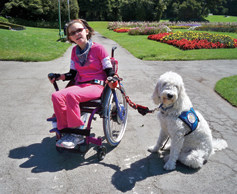
Elina Berglund Hughes, 16, from Grass Valley, Calif., has cerebral palsy. At age 10 she got her first pediatric-scaled Wijits at an Abilities Expo. Although California Medicaid would have probably paid for them, when Elina saw them, she was so excited that her mom didn’t want to wait, so she paid for them with cash. Mounted on Elina’s Colours Spazz chair, Wijits enabled her to wheel under her own power for the first time and “just be a kid.” The exercise from wheeling has helped strengthen her arms and has opened the tightness in her arms and balanced muscles that were uneven from CP.
Elina’s mom, Karla, says there were other reasons why they didn’t get a power chair for Elina. “The quick answer was we didn’t have funds for an adapted van and a power chair,” she says. “Also, we wanted her to use her own muscle strength for as long as possible. Wijits have increased her muscle and respiratory strength — it is always good to see her sweat once in a while!”
Elina is on her second pair of Wijits, having outgrown the pediatric size. “Now that I’m in high school, I have to race from class to class and I’ve actually been getting faster on my Wijits,” says Elina. “They really keep me in shape. And traveling with them is easy. My chair comes apart to fit into the trunk of a car.”
Details: Fits most folding and rigid wheelchairs. Weight of system 10-12 pounds per side.
Suggested retail is $4,995
Pivot Dual Lever Drive System: The heart of the Pivot system is the unique push-pull drive levers — a motion similar to rowing a boat. The “pull” part of the drive motion works the upper back and back-of-shoulder muscles which helps create better shoulder balance and posture. The drive levers are attached to wheels built around a five-speed transmission on a quick release hub. Moving the drive handles inward — mounted on a pivot on top of the drive lever — activates internal drum brakes to slow, stop and turn. Shifting gears is done via a shift lever on the side of each drive lever and can be done without finger movement. A toggle atop each push handle shifts into forward, neutral and reverse.
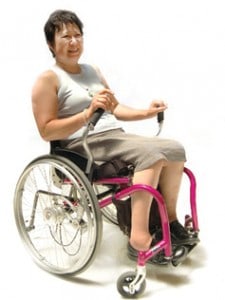
The Pivot fits on most manual chairs and is designed to accommodate a wide range of modifications, including the ability to remove power in either the push or pull part of the stroke, or adjust the shift toggle switch and gear shift for less strength or dexterity. One-arm drive is also available.
Sophanie Lim, 55, from San Jose Calif., is in her 30th year as a C3 incomplete quadriplegic. Lim was a full-time power chair user until three years ago when she heard about the Pivot system and tried a demo. It worked so well that she bought a Pivot system with money from her medical flexible spending account and had it mounted on her Top End Crossfire chair.
“They work great! I’ve been using them for three years and now my power chair sits at home,” says Lim. “Areas like carpet, hills and long distances that I could never do with push rims are now easy for me. The pushing-pulling has made my arms and shoulders a lot stronger, and I feel like the exercise has given me more energy. Plus with the Pivot, my hands never touch the rims, so they stay clean, which is great.”
Details: Weight of system is approximately 12 pounds per side. Suggested Retail is $3,950.
Power Assist
E.motion M15: The M15 is the latest generation of e.motion power assist wheels. They feature lithium ion batteries that triple wheeling range, and an ergonomic control system to customize the drive to meet the user’s needs (such as limited hand function). E.motions have a drive motor and battery integrated into the quick-release hub of each wheel and are compatible with most manual chairs. A sensor registers hand movement on the push rim and activates the motors to provide power assistance for forward, reverse, and turning, to match how fast you push the rims, up to 3.7 mph. They have a roll-back delay that prevents rolling backwards on inclines and an assist in braking — guided by push rim input — when going downhill. They have two settings, low for indoor and high for outdoor wheeling.
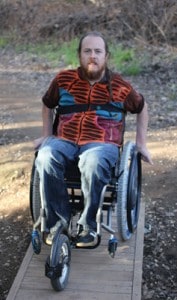
Micah Retz, 39, from San Diego, Calif., is in his fifth year as a C5-6 quad. Retz used a power chair for the first year after his injury. An avid traveler, Retz didn’t like his power chair limiting transportation to vehicles with a lift. The injury also left Retz in a lot of pain.
When he saw the e.motion M15 wheels, they were exactly what he was looking for. “I tried them, then got them and put them on a TiLite TR chair. They work great,” he says. “The arm movement exercise I get pushing the e.motions has greatly reduced my pain and is also burning calories, so I’m not gaining weight. They also allow me to be super mobile. The wheels pop off so my chair fits in the trunk of a car or taxi, making spur of the moment trips possible.” Although e.motion wheels are covered by most insurance, Retz wanted them right away so he paid cash.
Details: Maximum range: 16 miles. Weight: 24 pounds per wheel. Two e-motion models are available: the non-programmable M14 — suggested retail $7,075; and the programmable M15 — suggested retail $7,675.
Quickie Xtender: Sunrise Quickie Xtender power assist wheels are made by Yamaha — sold globally as Yamaha JW-II — and specifically designed for use with Quickie 2 on 2HP, GT and GP series chairs. The Xtender motors — integrated into quick-release hubs — sense hand movement on the push rims and provide power assist for forward, reverse and turning and will match push speeds up to 4 mph. For people with uneven arm strength, Xtenders’ “Smart Control System” evaluates each hand rim push to make sure the wheelchair drives straight. Xtenders provide rollback assistance going up inclines and an assist in braking — guided by push rim input — going downhill.
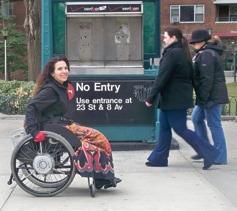
Nadina LaSpina, from New York City, has been using Extenders for six years. A polio survivor, LaSpina used a manual wheelchair all of her life. Six years ago she tore a rotator cuff, could no longer push her chair and didn’t want to go to a power chair. “I tried the Extenders and they worked great,” says LaSpina. She put them on her Quickie GP. “Wheeling feels the same as before. The power assist feels like I have my old strength and energy back. When the weather is nice, I go out on a bike path and push as fast as I can. Being outside and moving my arms feels great and burns calories, yet there is no strain, so my shoulders feel fine.”
Details: Maximum range: 9.5 miles. Weight: right wheel — 12 pounds; left wheel — 15 pounds; battery — 6 pounds (the battery fits next to the left wheel); axle plates — 2 pounds. Suggested retail: $6,595
E.Fix: E.fix turns a manual wheelchair into a joystick-controlled power chair. E.fix wheels have motors integrated into their quick-release hubs and an outer hub that can be easily turned from power to manual mode so the chair can be pushed with the push rims. The joystick mounts to the chair frame via quick-release and the battery mounts in a nylon pack under the seat attached to the frame by Velcro straps. The chair configuration stays the same so you can use standard wheels for times you don’t need a power chair.
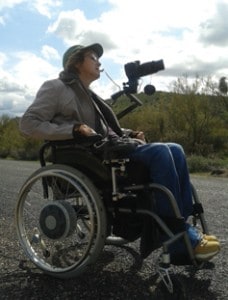
Peggy Thomas, 52, from Mesa, Ariz., is in her 30th year as a C5-6 quad. Thomas always used a power chair until she saw an E.fix at an Abilities Expo nine years ago. She liked it so much she got one.
“I like the E.fix because it is smaller and more compact than a standard power chair. It fits right onto my TiLite TR so I have the compactness of a manual chair and the same tight turning radius. I also like being able to reach down and turn the hubs to “unlock,” which takes it out of gear and turns it into a regular manual chair. Pushing the chair in manual mode is good exercise, and I know that I will never be stranded because of a dead battery. I drive a minivan with a lift so transferring is no problem.”
“I was just out birding with two people in standard power chairs and my E.fix chair worked just as well as theirs,” adds Thomas, a dedicated bird watcher.
Details: Range: 9.5 miles. Weight: Battery pack — 19.8 pounds; drive wheel — 17.2 pounds per wheel; joystick — 1.1 pounds. Top speed: 4 mph. Suggested retail: $6,595
SmartDrive: SmartDrive is arguably the first and only power assist that enables wheelers to independently load into and out of a standard car. It consists of an 8-pound, compact 14-by-6-by-1.5-inch battery that slides under the wheelchair’s sling seat, and an 11-pound power assist drive wheel that rides in between the rear wheels behind the center axle and is attached by slipping the end into place on a “T” axle attached to the center of the rear axle. Assembly and disassembly for car transfers takes about 45 seconds.
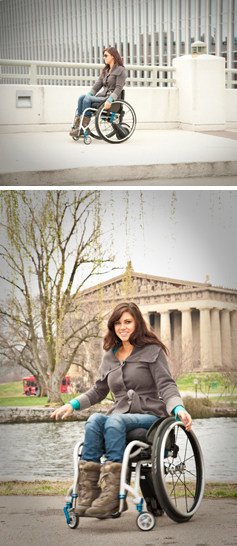
Photos by Robert Glover
The SmartDrive motor senses and reacts to acceleration and deceleration. A push on the push rings engages the motor, which will maintain your pushing speed — faster pushes equal faster speeds, up to 4.5 mph. To slow or stop, simply put pressure on the push rims and the motor will sense the drag (deceleration) and disengage. Going up an incline or encountering carpet or grass requires an extra push. Another option for starting, increasing speed or for going up hills, across carpets or grass, is to push and hold the power button located in front of the battery pack (between your knees). The longer the button is pushed, the faster the speed. A “quick push and release” on the power button is another option to disengage the motor.
The motor pivots up and down, which enables curb drops, wheeling on rough surfaces and wheelies. The chair can still easily turn, thanks to SmartDrive’s “omni wheels” that have discs mounted around the drive-wheel circumference, perpendicular to the rolling direction.
“After 17 years as an L1 para, I was getting such bad arthritis in my hands, wrists and shoulders that I was headed for a power chair, something I never want to do,” says Mike Hall, 53, from Clarksville, Tenn. In October Hall got a SmartDrive and mounted it on his TiLite ZR. “It has taken the strain off my shoulders, wrists and hands. They feel much better, and I’m out a lot more and doing a lot more. Plus, the extra power makes it easier to balance stuff in my lap because I don’t have to lean forward to push. It has the convenience of a manual chair with the ease of a power chair.”
The SmartDrive Hall is using is a loaner. He is working on getting his workers’ comp insurance to pay for one. “If they balk at paying for it, I’ve heard that the VA is paying for them, so I may try and run it through the VA.”
Details: At press time SmartDrive was compatible with rigid frame chairs only. A battery charges in five hours, and users report they charge batteries about twice a week. Weight: Battery — 8 pounds; motor/drive-wheel — 11 pounds. Suggested retail price: $6,450
Resources
• E.fix; e.motion, Frank Mobility, 888/426-858; www.frankmobility.com
• FlexRim; www.FlexRim.com
• FreeWheel, 208/571-2051; www.gofreewheel.com
• Pivot Dual Lever Drive, Rio Mobility, 415/278-9662; www.riomobility.com/en/
• Quickie Xtender, Sunrise Medical, 800/333-4000; www.sunrisemedical.com. Click on Wheelchairs, then Power Mobility. Xtender is at the bottom of the page.
• SmartDrive, Max Mobility; www.max-mobility.com
• Surge Handrim, Out-Front; www.out-front.com/surge_overview.php
• Users First, 718/803-3782; www.usersfirst.org
• Wijit, 800/659-4548; www.wijit.com
FreeWheel: For Off-Road and Urban Wheeling
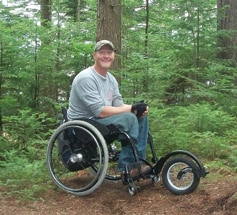
FreeWheel is a 12-inch wheel that quick-clamps to the footplate of a manual chair — on or off in a matter of seconds — and lifts the front casters just off the ground, instantly turning your chair into an all-terrain chair capable of easily pushing over gravel, dirt, grass, sand and snow. And if you need to be pushed, there is no more worry of flipping forward from your casters catching or digging — the 12-inch FreeWheel keeps you rolling.
I recently got a FreeWheel, and the first time I pushed it, I was hooked! Pushing on trails is great — where I used to constantly push in a wheelie lest I catch my casters and flip forward, now I can relax and push fast. Wheeling across the grass to watch my daughter’s soccer game was a breeze. It took less than half the pushing effort, and I didn’t have to wheelie to keep my casters off the grass and out of ruts. Even better, it makes pushing around easier by smoothing out the ride, gliding over caster-catching/slowing bumps and rough surfaces.
Micah Retz, a C5-6 quad, uses a FreeWheel combined with E.motion wheels, which enables him to go camping and explore hiking trails.
“As a quadriplegic my chair is set up to not tip back, so there is a lot of weight on the front casters, so they really get stuck on cracks or anytime I’m off the pavement,” says Retz. “The FreeWheel combined with the e.motion wheels can power through wherever I want.”
Retail: $499.00
Weight, Power and Independence
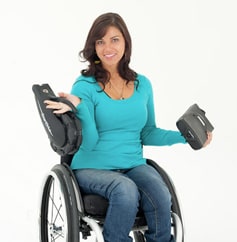
In general, power assist wheels, either pushrim or joystick controlled, are too heavy for compromised shoulders to lift into a car. Therefore, a vehicle with a lift or ramp is still needed for independent driving. Everybody interviewed in this story uses a vehicle with a lift.
The exception to this is the SmartDrive — its drive-wheel/motor assembly weighs 11 pounds, much less that the average wheelchair frame — and the battery weighs a mere 8 pounds. This author recently had the opportunity to try a SmartDrive, and it easily slips on and off the chair for car transfers — in about 45 seconds. A strap on the battery and a handle on the motor will most likely enable wheelers with limited hand function to do car transfers with the unit as well.
A Word on Funding
Mobility is priceless, but it isn’t cheap. It can often be funded using the right channels and documentation. The products in this article have been reimbursed by Medicare and VA and/or private insurance. This doesn’t mean every product will get funded for every person, or that it will be easy. It does mean you should be assertive in seeking funding for your equipment. To start the process you have several options.
UsersFirst: The best place to start is the UsersFirst Wheelchair Mobility Map located on the organization’s home page (see resources). Although it is set up for wheelchairs, it is also the comprehensive A to Z guide explaining every aspect of how to get whatever equipment you need — from how to get started, to how to get funding, including funding options, to delivery and maintenance. Reading through the easy-to-follow steps will give you a clear understanding of the process and your funding options. [Visit http://www.usersfirst.org/resources/mobilitymap/ to learn more about how to use this valuable tool.]
Therapist: Ask your physician for a referral to see your wheelchair clinician — usually a physical or occupational therapist. Ask them about the mobility equipment you are interested in and how you think it can enhance your mobility.
Manufacturer: Many of the manufacturer’s websites (see resources above) have funding information on the equipment you are interested in.
Durable Medical Equipment Dealer: Ask your local wheelchair dealer about the equipment you are interested in.
Support New MobilityWait! Before you wander off to other parts of the internet, please consider supporting New Mobility. For more than three decades, New Mobility has published groundbreaking content for active wheelchair users. We share practical advice from wheelchair users across the country, review life-changing technology and demand equity in healthcare, travel and all facets of life. But none of this is cheap, easy or profitable. Your support helps us give wheelchair users the resources to build a fulfilling life. |


I am a 54 Year Old T-3 Paraplegic and I have a Smart Drive MX1+ by Max-Mobility that is 2 years old, but only used in the Summer due to the Cold Snowy Winters here where I live in NH. I don’t really get a chance to use My Smart Drive much and have run into some financial problems and I am willing to sell My Great Running Smart Drive MX1+ for $2000. These go for over $5000 New, so this is a Great deal for someone who doesn’t have $5000 to spend on a new one.If anyone is interested I will also ship for Free in The USA! You can reach Me at 239-218-5983 or at:alan.duboyce@yahoo.com. Need to sell My Smart Drive ASAP. Thanks, Alan Duboyce